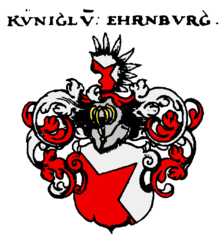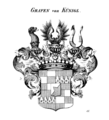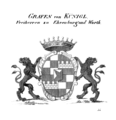Künigl (noble family)
The Künigl von Ehrenburg (also Kinigl) are a primeval Tyrolean knightly family who were elevated to baron status in 1563 and counts in 1662. Descendants of the Tyrolean and Bohemian lines live today. a. in South Tyrol and Austria.
Beginnings
Rudolph von Castelruth appears as the first ancestor in 1018 . The Chunig or Künig originally carried the predicate "von Kiens ".

Rudolph Kunig von Ehrenburg (1145–1224) named himself after the Ehrenburg in South Tyrol . With Stefan Künigl von Ehrenburg († 1411) the uninterrupted lineage of this family begins.
The family provided some priests and canons from the 15th and 16th centuries and, with Kaspar Ignaz, the Prince-Bishop of Brixen from 1702. Kaspar II was governor of the Principality of Brixen, vice governor in Innsbruck. His son Bernhard II. Künigl was first canon of Brixen / Trient (according to BKLÖ), after all his brothers died childless, he married in 1551 with papal permission to continue the line, in 1563 he became baron "von Ehrenburg". Johann Georg was governor in Tyrol, his son Johann Georg Sebastian also. He founded the Tyrolean Line and his son Leopold Josef founded the Bohemian Line, both of which still exist today. Since the enfeoffment of Veit Freiherr Künigl zu Ehrenburg and Warth in 1650 with the hereditary land truchess, the Künigl held this Tyrolean hereditary land office.
In 2010 they sold the Ehrenburg after almost 800 years.
Personalities
- Kaspar II. (1481–1541), chief steward of Trento and later imperial councilor, governor of the Principality of Brixen, deputy governor in Innsbruck
- Bernhard II. Künigl, first canon of Brixen / Trient, married in 1551, first baron "von Ehrenburg"
- Veit Ernst (1595–1664), since 1646 Colonel Truchseß of Tyrol, since 1662 Imperial Count
- Johann Georg Graf von Künigl (1628–1697), Imperial and Royal Privy Councilor and Governor of Tyrol
- Sebastian Johann Georg Graf von Künigl (or Sebastian Johann Georg, 1663–1739), Imperial and Royal Privy Councilor and Governor of Tyrol
- Kaspar Ignaz von Künigl (1672–1747), Prince-Bishop of Brixen
- Johann Philipp Nerius Joseph (1696–1770), Colonel Kitchen Master of Maria Theresa , Knight of the Golden Fleece, Chief Steward of the younger Archduke
- Alexander Josef (1704–1781), chamberlain of the Empress Elisabeth, chief hunter in Tyrol and kkw Geh. advice
- Leopold Franz Joseph (1726–1813), kk Geh. Council, Vice-President of the Upper Austrian Gubernium in Innsbruck
- Leopold Philipp (1764–1851?), Kk Geh. Council, princely Salzburg master hunter
- Ferdinand Felix (1805-?) Kk major in d. A.
- Hermann Peter von Künigl (1765–1853), Imperial and Royal Captain of the 3rd Artillery Regiment, most recently Feldzeugmeister
Elevations of rank and court offices
- Imperial coat of arms improvement in Regensburg on August 24, 1532 for Caspar Kunigl von Ehrenburg, Imperial Councilor and Court Marshal.
- Coats of arms association with the extinct von Weinegg and Belehnung with their castle Warth in Eppan 1536.
- Imperial baron status as "Freiherrn von Ehrenburg and Warth" Vienna on August 25, 1563 for Bernhard Khinigl von Ehrenburg
- Erbtruchseß von Tirol 1650 for Veit Ernst (1595–1664)
- Herbländisch-Austrian count status as "Counts of Ehrenburg, Barons of Warth" Innsbruck on May 4, 1662 by Archduke Ferdinand Carl of Austria-Tyrol for his Chamberlain Veit Khinigl Freiherrn von Ehrenburg and Warth
Members of the family reached the Landstandschaft of Carinthia in 1630, Count Leopold Joseph Künigl (1688–1727) became Count of Bohemia in 1713, Count Leopold Franz Joseph Künigl (1726–1813) was enrolled in the Bavarian count class in 1812.
coat of arms
Family coat of arms
divided by silver and red obliquely to the left and with a red tip emerging from the red half obliquely to the right, as a crest ornament an open flight obliquely divided with the tip, as in the shield, helmet covers silver-red.
Coat of arms from 1536
Ferdinand I allowed Kaspar II. Künigl von Ehrenburg to carry the coat of arms of the extinct Weinegger in 1536.
Shield quartered, 1 and 4 divided lengthways by red and silver, with a crossbar of alternating colors, and 2 and 3 in red a silver crossbar with black stripes on the top, four times tinned on top (coat of arms of those of Weinegg). Middle shield the coat of arms of the Künigl, helmets, crest? Silver-red helmet covers
Barons coat of arms
Coat of arms from 1536, crown of barons with two helmets, crest? Silver-red helmet covers
Count's coat of arms
Baron's coat of arms with the count's crown, on it three helmets with gold necklaces: the right helmet ornament two three-part red-silver buffalo horns in confused color, the middle an open flight diagonally divided below red with red tip, above silver, and the left a tinned tower with a growing red inward looking hound with tongue out. Red-silver helmet covers.
See also
literature
- Ernst Heinrich Kneschke : German count houses of the present in heraldic, historical and genealogical relation. Volume 1, TO Weigel, Leipzig 1852, pp. 492-495.
- Ernst Heinrich Kneschke: New General German Adels Lexicon , Volume 5, Leipzig 1864, pp. 318-319.
- Constantin von Wurzbach : Künigl, the counts, genealogy and history . In: Biographisches Lexikon des Kaiserthums Oesterreich . 13th part. Imperial-Royal Court and State Printing Office, Vienna 1865, p. 326 f. ( Digitized version ).
- Constantin von Wurzbach : Künigl, the counts, coat of arms . In: Biographisches Lexikon des Kaiserthums Oesterreich . 13th part. Imperial and Royal Court and State Printing Office, Vienna 1865, p. 329 ( digitized version ).
- Rudolf Johann von Meraviglia : The Bohemian Adel , 1885, p. 139.
Individual evidence
- ↑ Anton Emmert: Historical representation of the hereditary land offices in the ducal county of Tyrol and the associated hereditary homages on the occasion of the hereditary homage ceremony in 1838 , Innsbruck, p. 142, (see also 48, 148) limited preview in the Google book search



